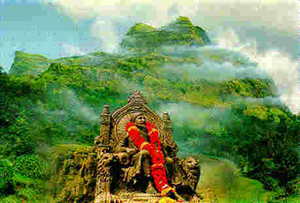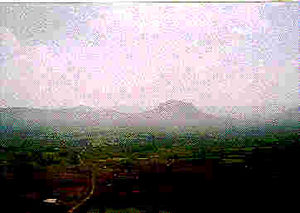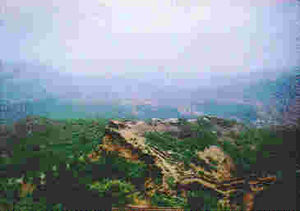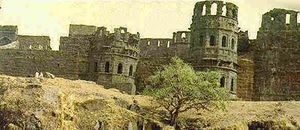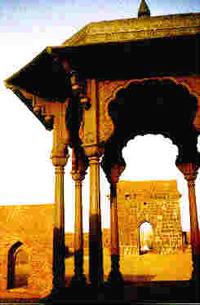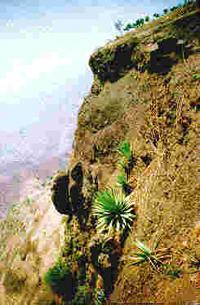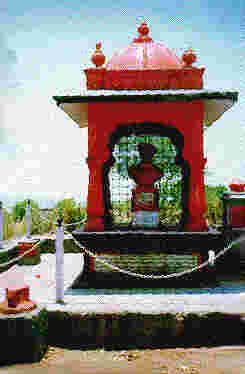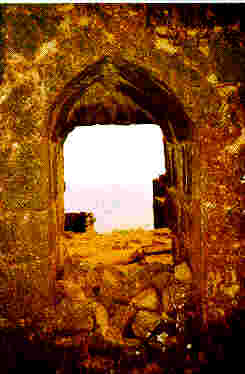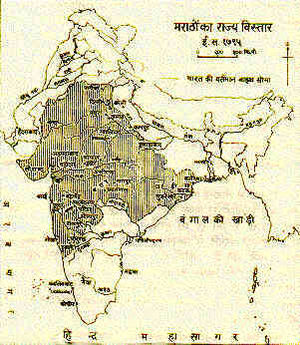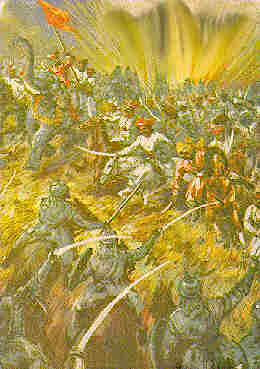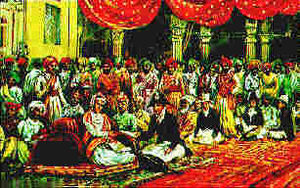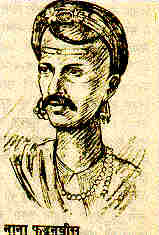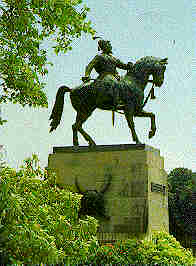The Marathas
By Shri Sudheer Birodkar
The Maratha are proud warrior race found mostly in the state of Maharashtra. They are first mentioned in Indian history as the stout fighters in the army of the Chalukya King Pulikeshi who resisted the Southward march of Emperor Harsha in the 7th century C.E. The Maratha dynasties of the ancient (pre-Muslim) period were the Chalukyas (500 C.E. to 750C.E.), the Rastrakutas (750 C.E. to 978 C.E.) and the Yadavas or Jadhavs (1175 C.E. to 1318 C.E.).
The last scion of the Yadava dynasty - Ramdev Rai Yadava who ruled from Devagiri (today's Daulatabad) clashed with Malik Kafur when he invaded the deccan in 1314 C.E. The Marathas lost to the invaders and accepted the status of being vassals and mercenaries of their Muslim overlords.
The Marathas before Shivaji[edit]
The Marathas before Shivaji were Mercenaries and revenue Collectors for the Muslim Rulers. In keeping with the feudal tradition, the Maratha generals kept shifting their loyalties from one Muslim ruler to another ruler like the Adilshahis at Bijapur, the Nizamshahis at Ahmednagar (Berar), the Qutubshahis at Golkonda (Hyderabad), etc.
Shahji Bhosale, Shivaji's father, typified this practice of shifting loyalties from one Muslim overlord to another. He was from time-to-time in the service of the Mughals, the Adilshahis and the Nizamshahis. The thought of establishing an independent Maratha-Hindu kingdom, does seem to have crossed his mind, but he never really got about to doing it successfully. The germ of this idea however seems to have got rubbed into Shivaji - his son by Jijabai.
Shivaji Maharaj - the Visionary Saint-Soldier[edit]
Shivaji was born in the year 1627 at the Fort of Shivneri in Maharashtra in Western India. Shivaji's mother Jijabai was a direct descendant of the erstwhile Yadav royal family of Devagiri. She seems to have nursed deep within her mind the idea of recovering independence from Muslim rule which her Yadav forebears had lost in the year 1318. Shivaji and his friends encouraged by Jijabai and his Guru Dadoji Kondeo decided to take a formal oath to free the country from the shackles of Muslim tyranny. This was done in the year 1645 in a dark cavern housing a small temple to the Hindu God Shiva (locally called Raireshwar). This was the beginning of a long and arduous Maratha-Mughal struggle that went on for the next century and a half to culminate in the defeat of the Mughals and their replacement by the Marathas as the dominant power in India.
Shivaji's encounter with Afzal Khan[edit]
When Shivaji started his military career by capturing the fortress of Torana, it sent shock waves in the Adilshahi court at Bijapur. Here was a local Hindu chieftain, daring to challenge the might of a Muslim ruler. Adil Shah sent in his most fearsome general named Afzal Khan to bring back Shivaji dead or alive to Bijapur. Afzal Khan, reputed to be more than six feet tall and of a real massive built, set on his mission and in order to lure Shivaji down into the plains, he destroyed the Hindu temples at Tuljapur, Pandharpur and Shikhar Shenganapur.
Shivaji kills Afzal[edit]
When Shivaji did not budge, Khan agreed to go up the hills at Pratapgad to meet his nemesis. When the meeting took place, Afzal Khan embraced Shivaji (Shivaji was less than five feet in height), Afzal suddenly tried to stab Shivaji with his dagger. On sensing that the Khan meant to kill him, Shivaji pierced the tiger claws he had deep into Khan's belly and pulled out his intestines. The Khan bellowed "Daga" "Daga" and yelled for Syed Banda, his bodyguard to come to his rescue. When Syed Banda, also a burly Muslim was about to strike Shivaji with his sword, Shivaji's bodyguard Jiva Mahalya struck off Banda's upraised arm in the air itself. Santaji Kawji, another of Shivaji's select warriors, then finished off the task of sending Khan to his final resting place. Khan's army which was waiting in the valley was ruthlessly massacred by the Marathas who were hiding behind every crevice and bush in the densely wooded jungles around the Pratapgad fort. At the place where this encounter took place on 10th November 1659 between Shivaji Maharaj and the Khan, there stands today a Kabar (grave) erected by Shivaji for Khan.
The Siege of Panhalgad[edit]
Despite this defeat, Bijapur's Adil Shah made one last attempt to check Shivaji by sending another general named Siddhi Jouhar against him. Siddhi besiged Panhalgad and the siege went on for some months, from summer till the monsoons. But Shivaji Maharaj slipped out of Panhalgad and reached safely at Vishalgad.
Encounter with Shaista Khan - Aurangzeb's Uncle[edit]
On hearing Shivaji's depredations, Aurangzeb was furious and wanted to desperately crush this infidel upstart. He sent his uncle maternal Shaista Khan with a large and powerful army to checkmate Shivaji. Shaista Khan came into Maharashtra and started devstating towns, village fields, temples, forts and everything that came in his path.
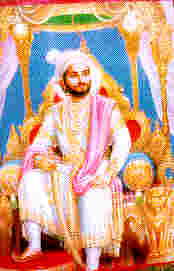
Shaista Khan’s encounter with Shivaji[edit]
To provoke Shivaji, Shaista Khan established his camp in Shivaji's home in Pune called Lal-Mahal. And to top it up, he put up his Harem in Shivaji's Devghar (prayer room). Shivaji bided his time for many months and on one fine night, he with a select band of Maratha troops, sneaked into the Lal-Mahal. He tracked down the sleeping Khan to his bed. The Khan sensing that his time was up tried jumping out of the window. At that point Shivaji cut off the Khan's fingers with which he was holding on to the window sill. On the Khan's wife's pleading, Shivaji spared the Khan's life. This was a mistake for which Shivaji was to pay dearly later. Shivaji made good his escape from the Khan's lair, but not before the treacherous Khan ordered his troops to give chase and try to capture the fleeing Shivaji. The Khan however, decided that enough was enough and returned to Delhi - without his fingers. This happened in April 1663.
Raja Jai Singh comes to Maharashtra[edit]
The failure of his uncle peeved Aurangzeb to no end and he now sent another general, Mirza Raja Jai Singh, Aurangzeb's Hindu general who was also the scion of the house of the Suryavanshi Kachhawaha. He and his general Diler Khan came with a powerful force and laid siege to fort of Purandar along with a systematic loot and destruction of rural Maharashtra. Murar Baji was the Maratha Fort Commandant at Purandar at the time. To break the morale of the Maratha troops, Diler Khan launched a viscious attack on the fort and succeeded in forcing their way into the outer defenses of Purandar.
But the Marathas were not easily intimidated. They withdrew to the inner fort and kept on their attack on the besieging Mughals. One day, Murar Baji decided to rain hell on the enemy and the Marathas stormed out of the fort and fell upon the Mughals who were occupying the outer fort. In face of the Maratha attack, the Mughals broke ranks and fled to their main camp in the plains below, where Diler Khan was camping.
The battle cost Murar Baji his life. The passing away of Murar Baji and the long drawn siege along with the destruction of the countryside forced Shivaji to reach out for a compromise with Jai Singh in the interests of the suffering population of Maharashtra.
The Treaty Of Purandar[edit]
The treaty of Purandar signed between Mirza Raja Jai Singh and Shivaji Maharaj had among many conditions, one condition that Shivaji accompany Mirzaji to Agra. Shivaji decided to go to Agra in 1666.
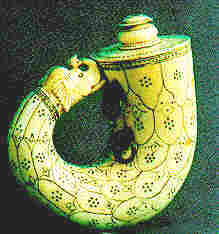
Shivaji's Visit to Aurangzeb at Agra and imprisonment[edit]
At Agra, when Shivaji presented himself at the Moghul court, Aurangzeb deliberately insulted him by making him stand behind a lesser noble whom Shivaji had once defeated in battle. This was a calculated humiliation that Aurangzeb had arranged for Shivaji. As a result Shivaji left the court in a huff. This gave Aurangzeb an excuse to declare Shivaji of having committed the offense of insulting the Mughal court.
Aurangzeb detained Shivaji in Mirza Raja Jai Singh's house where Shivaji had put up. Shivaji seems to have read Aurangzeb's mind of having him put to death. Auragzeb had made plans to shift Shivaji into the proper Mughal dungeons.
Shivaji's Escape from Aurangzeb's Clutches[edit]
Shivaji escaped from prison hiding in sizeable fruit and sweetmeats baskets which he used to send to Brahmins and holy men everyday from prison. In doing this Shivaji must have had in mind what had happened to his general Netaji Palkar who after being captured by the Mughals had been forced to embrace Islam and change his name to Quli Mohammed Khan. Netaji was forced to serve as a Mughal soldier in Afghanistan, till he too made good his escape and returned to Shivaji to reconvert to Hinduism and join the forces of Swaraj once again.
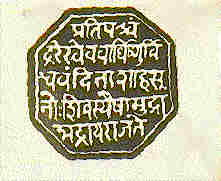
Coronation of Shivaji as Chattrapati[edit]
After returning to the deccan, Shivaji again raised an army and recaptured all the forts that he had been made to surrender to the Mughals as per the treaty of Purandar. In this phase we see the exploits of his brave general Tanaji Malusare who perished while recapturing the invincible fort of Kondana from Uday Bhan - the renegade Rajput who was the Mughal commandant of the fort. After all the forts had been recaptured, Shivaji was persuaded by Gaga Bhatt (a brahmin from Benaras) and his mother the aging Jijabai to formally crown himself as the king of the Marathas. The coronation took place at Raigad on the 6th of June 1674. The British and other foreign powers sent their representatives to the ceremony.
Narvir Tanaji's Impossibly Brave Deed[edit]
The fort of Kondana on the outskirts of Pune town was an outpost overlooking Pune and the surrounding countryside. It was strategically placed in the center of a string of forts of Rajgad, Purandar, and Torna. The capture of Kondana was necessary if Shivaji Maharaj was to re-establish de facto control over the Pune region.
Recognizing the strategic importance of Kondana, the Mughals had maintained a battalion of 5,000 troops led by Udai Bhan, a relative of Mirza Raja Jai Singh. The fort was built in such a way that all its approaches were covered by cannon-fire. Only one turret was not well defended as it was at the top of a vertical overhanging cliff.
At one night in 1669 when he was told that at the overhanging cliff Udai Bhan and all his senior commanders would be celebrating a usual party with an alcohol and dance orgy, Tanaji and 300 brave followers scaled the cliff using ropes tied to a reptile called Ghorpad. The Ghorpad can stick fast to any surface and a number of adults can use this force to scale a vertical cliff with the help of a rope, one end of which is tied to the Ghorpad. Silently Tanaji and his comrades slunk up to the top of the cliff.
On the other side his uncle Shelar Mama and his brother Suryaji had moved close to the other gates of the forts with another 300 Mavalas (Maratha Soldiers). On a signal from Tanaji, all his comrades who had taken up strategic position all round the celebrating Mughal army, broke into the party and mercilessly fell upon their enemies. They started slaughtering the surprised and ill-prepared and drunken Muslim soldiers.
On seeing Tanaji, Udai Bhan lunged at Tanaji and cut off the arm with which Tanaji was holding his shield. But undaunted Tanaji used his turban to ward off further thrusts from the blade of Udai Bhan's sword and continued fighting him for 2 hours in this state with his wristless left arm bleeding profusely. It is for this feat of Tanaji, that he is called Narvir - Brave amongst Men. At the end of this ordeal, the exhausted Tanaji fell to a fatal swish of Udai Bhan's sword. But Udai Bhan too was throttled by Shelar Mama and thus lost his life.
Shivaji Maharaj is said to have said on this occasion "Gad aala, paan Simha gela" (We have won the fort but have lost the Lion - Tanaji). The fort of Kondana was renamed as "Sinhagad" in honour of Tanaji's brave deed.
A "Nazarana" - The Daughter-In-Law of the Muslim Subahdar of Kalyan[edit]
During the days after the coronation, many Maratha generals presented Nazaranas (tribute in kind) to the newly anointed King of Maharashtra. It was then a practice of the Muslims to abduct any fair maiden and to force her into the harem as a concubine. On one such occasion, following the "illustrious" example set by the Muslim aggressors, a Maratha Sardar abducted a daughter-in-law of the Muslim Subahadar of Kalyan, near Mumbai (Kalyan was then under Mughal occupation) and presented to Shivaji as “Nazrana”.
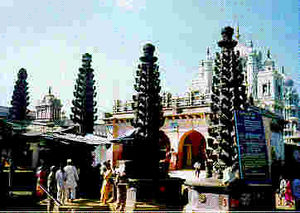
Shivaji Maharaj's reaction at this occasion, gives us an insight into the mind of the person who lived 300 years before us. Shivaji not only chided the general, but warned him and all the other Maratha generals that such a heinous offence would henceforth attract a penalty of the offender's hands being chopped off. The dazed general was asked by Shivaji to return with full honors, the daughter-in-law of the Muslim Subahadar of Kalyan.
The Maratha ballads (Povadas) that describe this event say that on hearing Shivaji's dialogue in Marathi the teenage girl is said to have exclaimed "Ya Allah, yeh aadmi nahin farishta hai. Ees farishtey pe kamyaabi bahal karna." ("O Lord, this is not an ordinary man but an angel. Bestow success on this angel.") The Maratha balladeers, while narrating this event say that "Asseech amuchi aai asatee,sundar roopavati; amhi hee sundar zhalo asato - vadaley Chattrapati" ("If my mother had been as beautiful, I too would have been as beautiful - exclaimed Chattrapati"). Shivaji Maharaj had risen above the attitudes of religious bigotry, and beastly behavior that had come to typify the Indian ruling class under Muslim rule.
Karnataka and Tamil Nadu Campaigns of Shivaji[edit]
Later, Shivaji launched his campaign in Karnataka, which took him up to Thanjavur in Tamil Nadu. The period from 1674 up his passing away in 1680 was a relatively peaceful period, as the Mughal made no more attempts to molest the Marathas. Only after the passing away of Shivaji Maharaj did Aurangzeb again dare to venture into Maharashtra, and then too he did not entrust the task to any general. He came himself in 1682 and stayed on in the Deccan till his death in 1707.
The Marathas After Shivaji Maharaj - Sambhaji[edit]
After the passing away of their illustrious leader, the marathas fell into relative disarray. Shivaji's eldest son Sambhaji did not prove adequate to the responsibility of preserving the flame of independence to which his father had given the initial spark. Sambhaji was extremely fearless and brave. Maratha chronicles (Bakhars) refer to him as in fact more assertive and independent than his father. But in addition, Sambhaji also had vices like wine and women. In his eventful life, Shivaji Maharaj did not seem to have had enough time to groom his successor. Sambhaji's temper had a short fuse. During Shivaji's life-time itself, he had once quarreled with his father and had gone over to join the Mughals as one of their Mansabdars. Subsequently, he realized his folly and came back to his father and repented. But this act deeply hurt his father and also displayed his chimerical nature for which he was to pay later with a painful death.
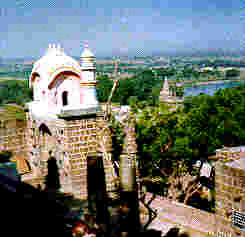
After the death of Shivaji Maharaj, Sambhaji was crowned as Chattrapati. He brazenly followed policies detrimental to the fledgling Maratha power. In this he was given short-sighted advice by his friend Kavi Kalash.
Sambhaji's death[edit]
Sambhaji did not falter in battling the Mughals, as well as the Portuguese. Aurangzeb, after subjugating the Bijapur and Golkonda kingdoms, turned his attention on the Marathas. He carried on a ceaseless campaign against the Marathas. Sambhaji performed many daring acts in this guerrilla campaign especially in the Konkan region. But in spite of his bravery, his short temper and his vices went against him. One night, when he was passing through Sangmeshwar with a small band of bodygaurds, he was waylaid by the Mughals and was brought in chains before Aurangzeb.
On being presented to Aurangzeb, Sambhaji was asked to surrender all his forts, accept Islam and enter the service of the Mughal Emperor. To this affront, Sambhaji scronfully replied that he could consider this if Aurangzeb gave him his daughter in marriage and proclaimed him as the successor to the Mughal throne! On hearing this Aurangzeb flew into a rage and decided to torture Sambhaji to death. Sambhaji's eyes were gouged, his tongue cut off, followed by his arms and legs. Sambhaji died an inhuman death, but till the agonizing end he never recanted his faith.
Rajaram, Tarabai and Shahu[edit]
After Sambhaji's assassination, his step-brother Rajaram became the king. He was not especially brave and is said to have been physically weak. During his time, Aurangzeb besieged and captured Raigad. Instead of fighting the enemy, Rajaram fled from Raigad when the fort was about to be besieged. Raigad fell into the hands of the Mughals in 1689 when a renegade Maratha called Suryaji Pisal betrayed the defenses of the fort to the besieging Mughals. During the capture of Raigad, Sambhaji' wife Yesubai and his son Shahu were taken captive by the Mughals. Rajaram's life as Chattrapati was spent mostly in fleeing from the Mughal armies. Nevertheless during his times, the generals like Santaji Ghorpade and Dhanaji Jadhav carried out a whirlwind guerrilla campaign to harass the Mughal army and never let Aurangzeb rest in one place. Thus in spite of his presence in the Deccan for more than 25 years from 1680 to 1707, Aurangzeb could not subsume the flame of independence lit by Shivaji Maharaj.
In 1700, Rajaram died of sickness and he was succeeded by his wife Tarabai. She was the nominal leader of the Marathas from 1700 to 1707, although the military activities were coordinated by the duo of Santaji and Dhanaji.
Aurangzeb's Death in 1707[edit]
When Aurangzeb died in 1707, his son Azamshah who was with him at his deathbed, proclaimed himself the Mughal Emperor and prepared to battle his elder brother Muaazam, who was then in Kabul. To ensure that the Marathas came over to his side, Azamshah released Shahu who was till then held as a prisoner by the Mughals. Shahu had been a prisoner for 18 years from 1689 up to 1707. When Shahu staked his claim to the throne, Tarabai was ruling. The battle between the two fought at Khed went in favour of Shahu and he became the Chattrapati. He was incidentally the last de facto Chattrapati of the Marathas.
Prime Ministers Peshwas become de facto Kings[edit]
During the days of Shahu, his general Dhanaji Jadhav had a very able accountant named Balaji Vishwanath Bhatt. This accountant rose in Dhanaji's favour by dint of hard work. His successful track record brought him visibility in the eyes of Shahu.
On Dhanaji's passing away, Shahu appointed him as his accountant. During this period, Shahu was attacked by forces loyal to Tarabai. To face this attack, Shahu appointed Balaji Viswanath Bhatt as a Senakarta (i.e. Commander). Balaji Viswanath proved to be an able soldier too. This increased the confidence Shahu had in him and he appointed Balaji Viswanath as his representative to negotiate with Kanhoji Angre, the Admiral of the Maratha Navy, who was at that time with Shahu's rival Tarabai. Before, Balaji Viswanath could take up this assignment, he asked Shahu to appoint him as a Prime Minister or Peshwa. To this request Shahu conceded and Balaji Vishwanath Bhatt became the Chattrapati's first Peshwa.
Balaji negotiated with Kanhoji Angre and both consented to accept the other's independent sphere of influence, with Balaji Vishwanath in charge of the Maratha military and Kanhoji in charge of the Marathas Navy. This agreement set the course for Balaji Viswanatha's rise as a Peshwa during his subsequent visit to Delhi with an army of 12,000 Marathas. During this visit to Delhi, on an invitation from the Syed brothers in their struggle with the Mughal Emperor Farrukhsiyyar, the Maratha forces led by Balaji Viswanath clashed with the forces of Mughal Emperor and defeated them. This was the first Maratha victory over the Mughals in Delhi. This event marks the ascendency of the Marathas in Delhi which lasted for almost a century till they were supplanted by the British in 1803.
The Peshwas - Baji Rao, Balaji Baji Rao, Madhav Rao[edit]
After Shahu, the de facto executive power passed into the hands of the hereditary Prime Ministers or the Peshwas. Balaji Viawanath Bhatt was succeeded by his son Baji Rao the first. Baji Rao was a very able and ambitious soldier and he was the one who consolidated Maratha power in North India.
The Spread of the Maratha Empire[edit]

Baji Rao died at a relative young age of 40 in the year 1740. His was succeeded by his son Balaji Baji Rao. Balaji Baji Rao played a tragic role in Maratha history and the fissiparous tendencies he let loose ultimately led to the downfall of the Maratha Empire.
His first mistake was to go back on the agreement between his grandfather Balaji Viswanath Bhatt and Kanhoji Angre according to which the Peshwa was to have no direct control over the Maratha Navy. He attacked his own navy and weakened one arm of the Maratha might.
The Persian Invasion Of 1740 By Nadir Shah[edit]
Persian King Nadir Shah attacked Mughals in 1740 and defeated them. Thereafter, Mughal power steadily declined and its place was usurped by the Rohillas who were led by an ambitious and ruthless chieftain named Najib Khan. Najib's ambition was to supplant the Moghal Emperor and crown himself as the ruler of India by capturing Delhi.
The Marathas Liberate Punjab[edit]
But the growing power of the Marathas in their northward expansion, stood between Najib and his ambition. To overcome the Marathas, in 1755, Najib invited Ahmed Shah Abdali from Afghanistan to help him in defeating the Marathas and crown himself the ruler of India. In this, he was thwarted by the Marathas led by Shrimant Raghunath Rao and Malhar Rao Holkar who decisively defeated the Rohillas and Afghans near Delhi in 1756. The defeat was so decisive that Najib Khan surrendered to the Marathas and became their prisoner.
After defeating the Afghan-Rohilla forces, the Marathas pursued the Afghans into the Punjab and beyond up to the Khyber pass. The last frontier of the Marathas was at Attock in today's NWFP (or Paktoonistan) on the Afghan border. This campaign of the Marathas led by Shrimant Raghunath Rao is called as Raghu's Bharari - i.e. whirlwind campaign.
Thus after nearly 800 after the last Punjabi King Tirlochan Pal Shahi had been defeated by Mahmud of Ghazni in 1020 C.E. did that part of India come under Indian rule in 1756 due to the liberation of Punjab by the Marathas.
The Dawn of Swarajya[edit]
Meanwhile with machinations and trickery, Najib Khan won over Malhar Rao Holkar and secured his release. On his release Najib started to undermine the Marathas once again and treacherously killed Dattaji Shinde (eldest brother of Mahadji Shinde). Najib continued to battle Shinde in 1757-58 and with his newly found confidence again invited Ahmed Shah Abdali to invade India.
Panipat - A Result of Court Intrigues at Pune[edit]
This success of Raghunath Rao aroused the jealousy of Balaji Baji Rao's wife Gopikabai, who started conspiring against Raghunath Rao to undermine his influence. This led to corresponding jealousy from Anandibai, Ragunath Rao's wife. The unfortunate fallout of this court intrigue was to end in the disastrous 3rd battle of Panipat in 1761.
This resulted in sidetracking of Raghunath Rao in favor of the Peshwa’s cousin, Sadashiv Rao Bhau (along with Viswas Rao the Peshwa's son and successor) as the Supreme commander of the Maratha forces that were to give battle to Abdali a second time. Had the Battle of Panipat been won by the Marathas, it would have changed the subsequent history of India and perhaps if there had been more astute rulers like Shrimant Raghunath Rao.
The 3rd Battle Of Panipat[edit]
When Abdali launched his second invasion in 1759, the Marathas, who after their successes in 1756 had been hibernating in Maharashtra and Central India, again woke up and formed an alliance with the Jat King Suraj Mal of Bharatpur. This alliance led by Shrimant Sadshiv Rao Bhau and Shrimant Vishwas Rao won spectacular victories and captured Delhi and Kunjapura (where the Afghan treasury and armoury was located). Here the alliance developed cracks due to the Maratha insistence on not allowing the Jats to loot Delhi. This ultimately split the alliance and Suraj Mal withdrew from the alliance. The Marathas consequently marched upto Panipat, but instead of continuing their attacks to completely defeat the partly defeated Abdali and Najib Khan, they stayed put at Panipat, blocking the way of the Afghans back to Afghanistan. Seeing their way back to their homeland blocked, the Afghans now became restless. They in turn, decided to block the way of the Marathas back into the Deccan.
The stand-off continued for one whole year from the 14th of January 1760 up to the 14th of January 1761. This led to the fall in the morale of the stranded Marathas and ultimately led to their defeat at Panipat. The Marathi term "Sankrant Kosalali" meaing "Sankranth has befallen us" comes from this event. During this stand-off the Afghans cut-off all supplies to the huge Maratha army. The Afghans with Najib Khan meanwhile also recaptured Delhi and Kunjpura. On the decisive day of 14th January 1761 (Makar Sankranti), the Marathas decided to break-through the Afghan blockade and re-enter Deccan. The disastrous battle saw about one hundred thousand Maratha troops being slaughtered in a matter of eight hours. But the Afghans too suffered heavy losses and decided enough was enough and went back to Afghanistan never to return to India. The defeat of the Marathas and the withdrawal of the Afghans created a power vacuum in North India in the period 1761-1790.
Madhav Rao[edit]
Madhav Rao, was the last of the astute Maratha rulers. His rule in the post-Panipat phase consolidated the weakening Maratha power which was to result in the initial Maratha successes against the British at the Battle of Talegaon in 1782 (1st Anglo-Maratha War) and at the Battle of Assaye (2nd Anglo-Maratha War) some years later.
The Sikhs meanwhile united under the leadership of Maharaja Ranjit Singh and carried on the unfinished task of the Marathas. The Sikh general Jussa Singh Ahluwalia invaded Abdali's kingdom, defeated Abdali ignominiously and captured his capital city of Kabul. The saffron flag (Nishan Saheb) then fluttered over Kabul after a gap of 800 years after Raja Jaya Pal Shahi lost the city to Sabuktagin in 980 C.E.
Mahadji Shinde[edit]
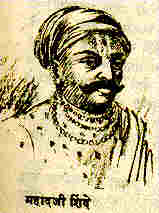
In the period between 1761 and 1790, the Maratha power was consolidated by Mahadji Shinde, Nana Phadnavis and Shrimant Madhav Rao Peshwa. Mahadji Shinde took initiative in military matters and he successfully checked the British in the first Anglo-Maratha war. Later of course, the Marathas were to succumb to the British after the third Anglo-Maratha war of 1817.
Maratha Rule Did Not Change the Feudal Relations of Production And Distribution[edit]
The feudal economic relations under the Maratha rule remained intact. Politically, the Maratha intermission from around 1720 to 1790 was too brief a period and they could not bring the entire country uniformly under their rule though the writ of the Marathas ran in the whole of western India with parts of the north and south under their domination. And in those parts of the country they ruled, the feudal relations did not undergo any fundamental change apart from the abolition of the Jazia penal tax levied on the Hindus by the Muslim rulers and general freedom from religious persecution of petty Muslim chieftains and representatives of the Muslim monarchy based at Delhi.
In other respects the change of rulers from the Muslims to the Marathas did not represent a departure from the feudal relations of production and distribution. The next stage in socio-economic development and new forms of landed property came about with the decline of feudal relations brought through British colonialism.
References[edit]
- Sudheer Birodkar, "A Hindu History: A Search for our Present History". Reprinted with permission.

